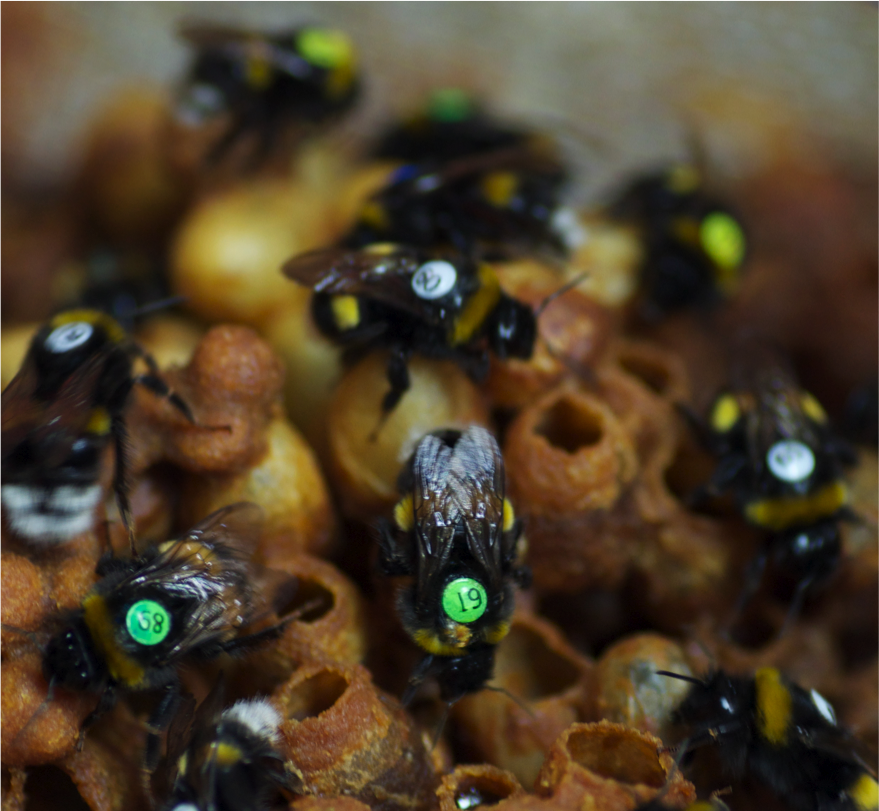Bumblebee immunological gene expression
The common European buff-tailed bumblebee, Bombus terrestris, is also commonly infected by the trypanosome gut parasite Crithidia bombi. Different colonies of B. terrestris are susceptible to different clones of the parasite, producing a complex genotype-by-genotype interaction, which is then moderated by environmental conditions (see here for a recent review with Ben Sadd on this system). I have been using quantitative PCR and RNA-seq to determine what is involved in bumblebee immunity to this parasite, and how individuals vary in their responses to this prevalent parasite.
The consequences of sex
Mating is an expensive activity, and the costs should be visible in reduced investment in other costly traits like growth. I’m studying how mating influences a variety of these traits in bumblebees and what it means in terms of disease resistance.
Comparative immunogenomics
Insects are remarkably diverse (there are an estimated 1 million species), and across that diversity is also an unusual degree of immunological diversity. Until recently, relatively little was known about the presence or absence of immune genes across species. Recent full genome sequencing suggests that insects can be quite different in the makeup of their immune system. In some species, like the pea aphid, entire portions of the ‘normal’ insect immune system are missing. In other cases, like honeybees, all the players are there but the number of immune genes is reduced. I’m working with the Bumblebee Genome Consortium to annotate and analyse the immune genes of two bumblebee species, Bombus terrestris and Bombus impatiens to try and understand how the immune system differs across arthropods in general and, more specifically, how the immune system of social insects has evolved alongside the transition to sociality.
![. Examples of non-immunological defense. The extent to which nonimmunological defense influences host–parasite dynamics, varies among individuals, and imposes costs differs among defenses and study systems. In general, it is important to demonstrate that a trait is adaptive for a host and is not a mechanism of parasite manipulation [83] before it can be considered to be a nonimmunological defense. Other physiological traits, such as feeding rate [23], might evolve as a consequence of parasite pressure, but are not the focus here because they are not active responses of individuals to parasitism. Photographs, from top to bottom, by A. Hunter, R. Naylor, E. Sternberg, P. Schmid-Hempel, S. Adamo, T. Barribeau, and T. Little. Published in TREE](http://seth.barribeau.com/wp-content/uploads/2013/03/tree_fig.jpg) Non-immunological responses to infection
Non-immunological responses to infection
The immune system is expensive to develop and to use. As a consequence, species have evolved a number of adaptations that help protect them from parasites without necessarily invoking the traditional immune response (see my review with BenParker and coauthors here). When faced with infection one responses is to forgo an expensive immune response and instead invest all of your resources into reproduction. This shift in life history strategy is known as fecundity compensation and it seemsespecially adaptive when the situation is dire where infection probability is high and resistance is unlikely. Since pea aphids are missing so much of the normal insect immune system, fecundity compensation may be especially important. I previously found that aphids reproduce earlier when they have been given cues of infection, or even cues of risk, but this raises a different question: why don’t they reproduce early and fast all of the time? Working with Gabriel Leventhal and Robert Dünner we’re now using a mix of models and experiments to assess the conditions where fecundity compensation is likely to to succeed to understand why this strategy of early reproduction isn’t the default strategy.
The costs of immunity
The immune system is expensive and costs of using it have been found across a wide variety of organisms. While much of the pea aphid immune response to Gram-negative bacteria is missing, it’s unclear whether aphids have other, novel, immune defences against this common class of bacterial parasites. Working with Ben Parker and Nicole Gerardo, we’ve been using the costs of immunity to try and detect novel immune responses. We are also exploring how these costs are distributed across different components of the immune response.
